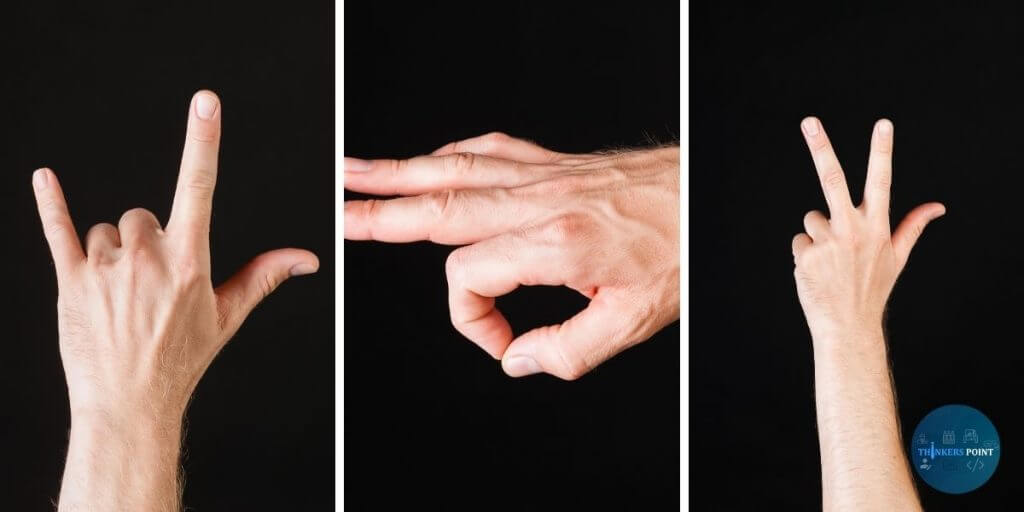Non-verbal communication is the type of communication which does not involve speaking or writing. It is far more beyond the world of words and speeches. Non-verbal communication is a type of communication that happens with the exchange of signals, gestures, body language, facial expressions, and many more.
We have often heard the proverb, ‘Action speaks louder than words.’This proverb says a lot about non-verbal communication and its importance. Even when you are communicating verbally, your expressions, gestures, body language says a lot about you and your message.
It leaves an impression on the receiver of the message. It gives clues to the other person about your personality and leaves an impression on them.
Even when communicating verbally, you exchange non-verbal messages which can affect what you are speaking. Non-verbal messages can ruin your speech and affect the meaning of your message if it is not up the mark. Your expressions, gestures, body language can always be judged for your personality.
Taking a simple illustration, if you are asked if you want to learn more about non-verbal communication? And you say yes while nodding your head for a no, it can confuse the other person. See, this is why it is necessary to keep your verbal and non-verbal messages on the same track.
Interpersonal communication is not only speaking or communicating verbally but also the non-verbal communication you do, matters in the process of communication.

Suppose, your friend is saying that he/she is very happy but isn’t laughing or smiling at all. Will you believe? You will have an instant doubt in your mind because his verbal message is not matching with his non-verbal message.
Non-Verbal Communication at the Workplace:
When people get ready for an interview, they often decide and practice what they want to say or will say. They get themselves ready with a nice speech, but they often leave the main part – How will they behave or act?
They ignore this major part of the evaluation in the interviews. Here are some basic points about how one could show our non-verbal skills in the interview -Have a calm expression on your face, don’t look too excited or too nervous, just be confident and look calm.
Do not slouch. Sit straight, without leaning on the chair. While answering, look into their eyes, again calmly and also keep shifting your eye contact. Avoid the use of hands unnecessarily. Do not sit cross-legged. Keep your phone on silent mode. Do not interrupt while they are speaking, wait for your turn. Keep your voice tone moderate, for everyone to listen clearly.
Nonverbal communication skills can be in your favor and can also stand against you. This depends on how well you know about non verbal skills, and how well you pursue them. Matching of the non verbal factors with your verbal message will be favorable for you.
At the workplace, while communicating with anyone be it your colleague, your team leader or your boss, it is very important that you behave and act in a proper manner. Your small everyday good morning wish to your colleagues or your boss can make you look good in their eyes. Your non verbal skills demonstrate your personality and your sincerity.
Significance of Body Language in Presentation
At the workplace, the most important task is when you are about to represent something like presentations to clients, in conferences. While your presentation, your voice tone and pitch, body language demonstrates your confidence and knowledge.

It speaks a lot about how well you have prepared your presentation. These non-verbal skills will help you keep your audience interested and focused on your subject or message.
The way you greet your clients, your boss, your colleagues leaves an impression of yours on them. It will also help them remember you. Keeping yourself in people’s good books is always like keeping hurdles away from your racing track.
Aspects of Non-Verbal Communication:
There are many aspects of non verbal communication, well, we can start with the most common one i.e. facial expressions. Facial Expressions, Talking about facial expressions, we all do it, all the time, with friends, family, colleagues, and even strangers.
We try to read their faces, which basically means analyze their facial expressions, and understand the message underlying. Smiling, frowning, eyebrow twitch, nostril flare, eyes rolling, blinking are all examples that can be noticed without making any efforts, these expressions can give sure short messages to the observer about your intentions, emotions, or any type of message.

Kinesics or Body Movements:
We all know people who talk with their hands, it’s like speaking while making numerous hand gestures, this is one of the most common examples of Kinesics.
However, body movements rather than hand gestures like nodding, involuntary tremors, frequent throat clearing, shaking off your legs are all considered body movements which are not good while official meetings.
They are often considered nervous and don’t leave a good impression. These are the distractions that can ruin your message and your impression. Kinesics is a very important part to be taken care of while delivering your message as they are often involuntary.
Paralanguage
The tone of your voice has a significant effect on the message you are trying to convey. Paralanguage is when you are giving some message but your tone of voice does not match the message being conveyed.
The best example of paralanguage is sarcasm. We all are aware of what sarcasm is and what it feels like. Sarcasm is using the exact opposite voice tone of the message you are giving.
Other examples of paralanguage are speed of your voice, pitch and even volume. It is advised not to be in a hurry while speaking or delivering the message, keep the tone of voice high but not very high, avoid murmuring, speak clearly, be loud enough to be heard by each and every listener, remember being loud is nowhere equivalent to shouting.
Proxemics
Proxemics suggests the distance between the speakers and the listener. How close or how far they are? It is very important to know, as it decides the volume and tone of the voice.
The distance is also determined by the relationship the speaker and the listener are involved in. Whether they are engaged in some formal or informal relationship. Suppose in a meeting it is advised to keep a normal and safe distance i.e. neither too close nor too far, to make the environment comfortable.
Postures
Postures play an important part in determining your impression in people’s eyes and make perception about you. How you sit or stand makes a difference in your impression on others.
Having an open posture is very important to develop a healthy relationship and convey the message in an intended manner. Standing or sitting with your back straight, your arms open, calm expressions, head held high are examples of open postures.
Eye Contact
Not only with known people, but also with strangers, eye contact can play a major part. While having a conversation, with anyone, maintaining eye contact is very important.
It shows the person’s interest, attention and involvement in the conversation. Not able to make eye contact can show the other person that you are not interested or not involved in the conversation, it can show that you are being rude. But it is also not advised to continuously and intensely stare at anyone. It can make them feel awkward or even scare them.
Haptics
For, conveying some message, not only speaking helps, but also with touch you can convey messages. For instance, a mother’s soft touch conveys care and love to the child. This is basically related to the emotions. Your touch conveys your feeling or emotion toward others.
Importance of Non-Verbal Communication
- Supports your speech or puts stress on conveying the intention behind your message.
- Shows or conveys your mental state or your well-being.
- It defines the type of conversation you are involved in – formal or informal.
- Smile or calm reactions or may angry, or sad expressions help in understanding of the feedback.
- Gestures, body movements, eye contact and many types of non-verbal communication help in maintaining the interest and involvement in the conversation.
As we know interpersonal communication skills can be learned through practice, so we can say that verbal and non-verbal, both types of communication can be learned through practice.
Non-verbal communication can be conveyed in your consciousness, and it can be conveyed unconsciously. Our facial expressions, some gestures and body movement, even haptics are all controlled by our subconscious mind. Whereas there many of them that can be practiced and learned.
Here are some tips, and tricks you can use to improve your non-verbal ability –

Well, there are none, there are no tricks that can help you learn non-verbal communication skills. But you can always focus and control them with regular practice, and active consciousness. Non-verbal communication skills are way more important than they seem.
Non-Verbal Communication skills are very important, and it is very important that you control them the right way. The best of your non-verbal abilities you can show will bring the best for you in your career as well as in relationships. You should be aware of how you are behaving or posing in front of others.
FAQs
1.What are types of non-verbal communication?
The types of nonverbal Communication are : environmental, appearance based and artifacts, proxemics and territoriality, haptics, paralanguage, chronemics, kinesics, gestures, facial expressions and eye contact.
2.What are six categories of non-verbal cues?
The six categories of non verbal cues are : Body language, vocal cues, appearance and grooming, spatial cues, environmental cues, and miscellaneous.
3. Is silence a form of non-verbal communication?
In reality, silence can be a very effective communication tool. Communication is simply about conveying a message, and sometimes silence can do that better than any words. In fact the studies say that 93 percent of communication is nonverbal. Your gestures, expressions convey your feelings and emotions more strongly than any other word.
4.What is good non-verbal communication?
Paying Attention to nonverbal signals is good for good non verbal communication. People can communicate or convey messages in numerous ways, so paying attention to things like eye contact, gestures, posture, body movements, and tone of voice is a great help.
5.Why is non-verbal communication so important?
Nonverbal communication describes the process of shared cues between people, which goes hand-in-hand with public speaking. Nonverbal signals increase trust, clarity, and add interest to your presentation or message when yielded properly. That is why non verbal communication is very important.
6.What are the functions of non-verbal communication?
The functions of non verbal communication consist of : complementing verbal messages, substitution for verbal messages, accenting verbal messages, contradicting verbal messages, repeating verbal messages, and regulating verbal messages.
7.How do you understand non-verbal communication?
The following tips can help you learn to read the nonverbal signals of other people and enhance your own ability to communicate effectively.
- Pay attention to nonverbal signals.
- Look for incongruent behaviors.
- Concentrate on your tone of voice.
- Pay attention to eye contact, do not stare.
- Ask questions about non verbal signals.
8.How does non-verbal Communication Affect the Verbal Message?
All of our non verbal behaviors – the gestures that we make, our posture, our tone of voice, how much eye contact we make, all of these factors, sends strong messages to the listener.
9.How can verbal and non-verbal communication affects relationships in the workplace?
Your non verbal signals should reinforce what you’re saying. So, we should make sure your verbal and non verbal messages match. The ability to use non verbal signals appropriately can create trust and transparency, and therefore can influence the quality of your relationships at work.
10.What is the difference between verbal and non-verbal communication?
Verbal communication involves the use of words or speech or auditory language to express emotions or thoughts or exchange information. Whereas, Non-verbal communication involves the use of visual or non-verbal cues such as facial expressions, eye or body movements, gestures, and many more without speaking.
11.What are non-verbal communication advantages and disadvantages?
Despite the advantages of non-verbal communication, it is not free from its disadvantages which are : Non verbal communication is quite vague and imprecise. Since in this communication, there is no use of words or language which expresses clear meaning to the receiver, it is very difficult to understand it.
Do check out our blogs on other soft skills
- Communication skills
- Teamwork
- Dependability
- Conflict resolution
- Leadership
- Problem-solving
- Creativity
- Work ethics
- Integrity

